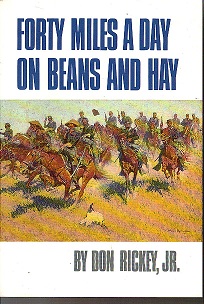
We wint to Arizona,
for to fight the Injins there;
We came near being made bald-headed,
but they never got our hair.
We lay among the ditches,
in the dirty yellow mud,
And we never saw an onion, a turnip, or a spud.
Ah, the glamor of serving in the United States Regular Army during the Western Expansion! After I posted my review of Archaeological Perspectives on the Battle of the Little Bighorn, I was pointed to another book on the period, Don Rickey Jr.’s Forty Miles a Day on Beans and Hay
. It is a study of the daily life of the enlisted soldiers of the US Army during the Indian Wars of the latter 1800s, and notable in particular for being based heavily on firsthand accounts, both written and oral. The book was published in 1963, and Rickey had the opportunity to converse with living veterans of the Indian Wars in the process of researching it.
Rather than being an account of the specific campaigns and battles of the Indian Wars, Forty Miles a Day is about the daily lives of the enlisted men. It begins with the recruiting depots, training, company organization and ranks, regular duties on the western frontier, discipline and desertion, recreation, crime and punishment, preparing for campaigns, combat itself, heroism and cowardice, and discharge. The writing is interesting and engaging, and scarcely a page goes by that does not include a direct quote from a soldier. These mens’ recollections cover subjects like:
- How various Companies were able to augment the issued rations of hardtack, bacon, coffee, and salt pork by trading with civilians, hunting game, and maintaining Company vegetable gardens
- How uniforms were modified in the field to be more practical and comfortable
- The change in official attitude towards marksmanship, which was utterly ignored until the late 1870s, when the Army made it a priority and encouraged men the practice on the rifle range
- What backgrounds the enlisted men came from – small-time criminals, unlucky businessmen, young men looking for adventure, Civil War veterans, immigrants, and others
- The ever-popular prank of mixing some full-power .45-70 cartridges into the ammunition box of a cavalryman accustomed to his lighter .45-55 ammunition
- How Companies were required to reload spent cases to supplement ammunition supply, and this duty was often used as punishment
Rickey’s work is generously littered with firsthand anecdotes, and in rereading this review, I can tell that I’m not making the subject sound nearly as interesting as the author makes it. In reading Forty Miles a Day, you need only close your eyes for a moment and the whole landscape of nineteenth-century Fort Sill or Fort Keogh. The grousing of privates, the illicit-but-overlooked poker game for tobacco, the fatigue duty squad hauling barrels of water into the fort for the day, and the one-size-fits-none blue wool uniforms. So much of the daily quality of life of these men depended on the quality of their Company officers, whose apathy could let a cruel First Sergeant terrorize a unit or whose aptitude could have the men eating sumptuously on milk, eggs, and fresh vegetables. Whether you are particularly interested in this period of history or not, Don Rickey will draw you into those days on the frontier and you won’t want to stop reading.
Happily, Forty Miles a Day is still very easily available, with new copies priced under $14 on Amazon, and used copies starting at $4 shipped:

Aaaaaand purchased.
It is worth noting that the emphasis on marksmanship in the 1870’s U.S. Army was a direct result of the founding of the National Rifle Association in 1871. General Burnside and other Union generals were distressed by the poor performance of Union soldiers during the Civil War, particularly when compared to their Confederate opponents. Generals Burnside, Wingate, and other former Union generals founded the NRA to force marksmanship training on the U.S. Army.
I’m sold.
Looking on Amazon listing (which I will buy) there was also this listing for an MP3:
Forty miles a day on Beans and Hay – Guy Mitchell by Inc 7th Voyage Productions (Mar 28, 2012)
I hope the 0.01c ones are legit 😛 If so, it’s coming my way. Sounds very interesting and unique, good opportunity to learn what people did and why straight from the horse’s mouth (and the cavalryman on top of it!).
They should be – I’ve bought more than a few books with that type of deal through Amazon.
A similar book using first hand oral histories and interviews albeit from a different period is Studs Terkel’s “The Good War” around WWII. Then a stretch further is that this format that Terkel was famous for was used for the format of the zombie book “World War Z”
I remember when I was in the Army in the ’80s, Terkel would have an annual “No More Hiroshimas Day” on his radio show on public (or Pacifica) radio. My response was that we really needed instead, a “No More Nankings Day”. After that got going, we could think about remembering things that happened to the Japanese because of the things they’d done to other people… which at the time they were still minimizing, excusing, or outright denying.
Another book that may interest those who want to know more about Little Bighorn battle is SLA Marshall’s Crimsoned Prairie. His other books on military history and military education are excellent, too. He had many detractors in academic circles, and quite a few popped up after his death, don’t let that sway you.
Many the young man I have known planning to become an officer in our military I have slapped a copy of Men Against Fire into the hand of, and if you are interested in the operational facts of the Korean War you should damned well get copies of The River And The Gauntlet and Pork Chop Hill.
https://www.youtube.com/watch?v=LpFh_9BEyOM